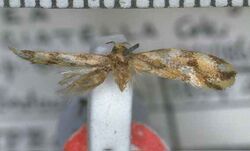Biology:Tingena plagiatella
| Tingena plagiatella | |
|---|---|

| |
| Male holotype | |
| Scientific classification | |
| Domain: | Eukaryota |
| Kingdom: | Animalia |
| Phylum: | Arthropoda |
| Class: | Insecta |
| Order: | Lepidoptera |
| Family: | Oecophoridae |
| Genus: | Tingena |
| Species: | T. plagiatella
|
| Binomial name | |
| Tingena plagiatella (Walker, 1863)[1]
| |
| Synonyms[2] | |
| |
Tingena plagiatella is a species of moth in the family Oecophoridae.[2] It is endemic to New Zealand and has been observed in both the North and South Islands. This species inhabits light native bush or scrubland. Adults of this species are on the wing from November to January.
Taxonomy
Francis Walker described this species in 1863 using specimens collected by D. Bolton in Auckland and named the species Tinea plagiatella.[3][2] In 1915 Edward Meyrick placed this species in the genus Borkhausenia.[4] In 1926 Alfred Philpott studied the genitalia of the male of this species.[5] George Hudson discussed this species under the name Borkhausenia plagiatella in his 1928 publication The butterflies and moths of New Zealand.[6] In 1988 J. S. Dugdale placed this species within the genus Tingena.[2] The male holotype specimen is held in the Natural History Museum, London.[2]
Description
Meyrick described this species as follows:
Male . Whitish. Head and thorax slightly tinged with ochraceous. Abdomen brownish cinereous above, extending much beyond the hind wings. Wings long, narrow. Fore wings hardly acute, irregularly speckled with brown ; a blackish streak extending from the base ; two blackish spots in the disk, opposite two others on the interior border ; a white spot behind the second blackish spot ; three brown costal spots ; two brown exterior streaks, one extending to the fore part of the exterior border, the other to the interior angle ; two diffuse ochraceous discal patches ; exterior border extremely oblique. Hind wings aeneous. Length of the body 2 1⁄2 lines; of the wings 8 lines.[3]
Distribution
This species is endemic to New Zealand.[1] It has been observed in Auckland, Tokaanu, Ōrongorongo Valley in the Wellington region and Arthur's Pass.[3][7][8] This species has also been found in a site of ecological significance in Christchurch as set out in the Christchurch District Plan as well as at Rakaia Island in Canterbury.[9][10]
Behaviour
Adults of this species are on the wing from November to January.[6]
Habitat and hosts
This species inhabits light native forest or scrubland.[6] The larvae of this species feeds on leaf litter.[10]
References
| Wikimedia Commons has media related to Tingena plagiatella. |
- ↑ 1.0 1.1 , pp. 462, Wikidata Q45922947
- ↑ 2.0 2.1 2.2 2.3 2.4 , pp. 104, Wikidata Q45083134
- ↑ 3.0 3.1 3.2 , pp. 485, Wikidata Q109352878
- ↑ , pp. 213, Wikidata Q63123349
- ↑ , Wikidata Q110157185
- ↑ 6.0 6.1 6.2 , pp. 270, Wikidata Q58593286
- ↑ , Wikidata Q110407301
- ↑ "Tingena plagiatella". 2021. https://www.aucklandmuseum.com/collections-research/collections/record/am_naturalsciences-object-177227.
- ↑ Hooton, Scott (27 January 2015). "Christchurch District Plan. Site of Ecological Significance. : Lake Forsyth North Side". https://districtplan.ccc.govt.nz/Images/DistrictPlanImages/Site%20of%20Ecological%20Significance/SES%20H%2018.pdf.
- ↑ 10.0 10.1 , Wikidata Q110407284
Wikidata ☰ Q13861735 entry
 |

